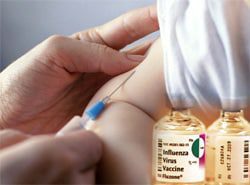
The vaccine for the H1N1 pandemic virus may likely have increased the risk of people suffering Guillain-Barré syndrome, according to new research from Canada. FamilyPracticeNews.com reports that researchers at Laval University in Quebec, Canada, have discovered a slightly increased risk for the disease among people who received the “swine flu” vaccine compared to those who […]
 The vaccine for the H1N1 pandemic virus may likely have increased the risk of people suffering Guillain-Barré syndrome, according to new research from Canada.
The vaccine for the H1N1 pandemic virus may likely have increased the risk of people suffering Guillain-Barré syndrome, according to new research from Canada.
FamilyPracticeNews.com reports that researchers at Laval University in Quebec, Canada, have discovered a slightly increased risk for the disease among people who received the “swine flu” vaccine compared to those who did not, about an extra two cases per million people innoculated with the vaccine. The study has been published in the Journal of the American Medical Association.
Quebec, like many other provinces in Canada and states domestically, launched an aggressive campaign in 2009 to combat the potentially deadly H1N1 (swine flu) virus. About 96 percent of all 7.8 million Quebecers received the vaccine, inactivated monovalent ASO3 influenza A(H1N1) vaccine, marketed by GlaxoSmithKline as Arepanrix. Tens of millions more received the vaccine in North America.
Researchers discovered at least 83 cases of Guillain-Barré syndrome among those receiving the vaccination in 2009, a rate of about 2.3 per 100,000. This is higher than previously reported rates among people receiving the “swine flu” vaccine, which was about 1.1-to-1.8 per 100,000. The highest risk of developing Guillain-Barré syndrome appeared to be in the weeks and first months after receiving the H1N1 vaccine.
The study compiled by researchers at Laval University noted “clusters” of Guillain-Barré syndrome among 56 people in the first three months among those who received the vaccine. There were no “clusters” of Guillain-Barré syndrome among people who did not receive the vaccine. The highest risk was discovered during the first four weeks after receiving the vaccine. And only those over the age of 50 appeared to be at risk of developing Guillain-Barré syndrome after receiving the “swine flu” vaccine.
A previous report from the U.S. Centers for Disease Control and Prevention arrived at similar results to this latest Canadian study. In it, there were about 1.5-to-2.8 cases of Guillain-Barré syndrome per million people who received the vaccine.
While some studies have found no risk of developing Guillain-Barré syndrome among people receiving the vaccine, there were increased reports of the disease following a rush in 1976 to combat the same H1N1 virus. Then, about 1 in every 1 million people were expected to develop Guillain-Barré syndrome after getting the regular flu vaccine. The risk elevated to about 1 per 100,000 among those receiving the “swine flu” vaccine.
In 2009, the CDC received at least 1,700 reports of people receiving the H1N1 vaccine who developed Guillain-Barré syndrome. At least 40 million people in the U.S. received the “swine flu” vaccine in 2009 amid fears the potentially deadly virus was spreading across the country. Federal health officials suspected that as many as 4,000 people in the U.S. may have died from the H1N1 virus or complications caused by it.
The Canadian study indicated that the risks of receiving the vaccine did not compare to the actual risk of being infected with the virus.
More vaccine-related cases:


